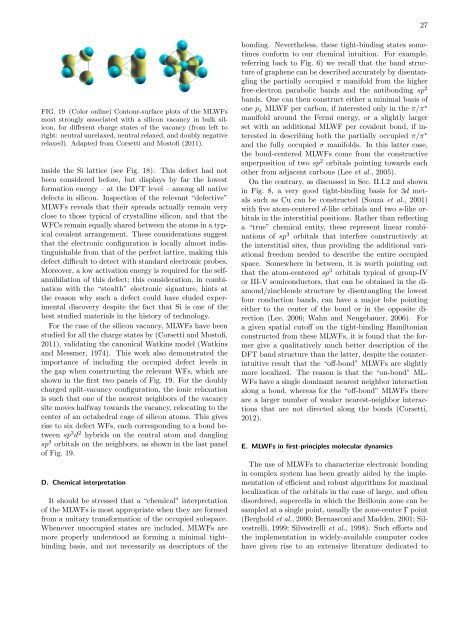Maximally localized Wannier functions: Theory and applications
Maximally localized Wannier functions: Theory and applications
Maximally localized Wannier functions: Theory and applications
You also want an ePaper? Increase the reach of your titles
YUMPU automatically turns print PDFs into web optimized ePapers that Google loves.
27<br />
FIG. 19 (Color online) Contour-surface plots of the MLWFs<br />
most strongly associated with a silicon vacancy in bulk silicon,<br />
for different charge states of the vacancy (from left to<br />
right: neutral unrelaxed, neutral relaxed, <strong>and</strong> doubly negative<br />
relaxed). Adapted from Corsetti <strong>and</strong> Mostofi (2011).<br />
inside the Si lattice (see Fig. 18). This defect had not<br />
been considered before, but displays by far the lowest<br />
formation energy – at the DFT level – among all native<br />
defects in silicon. Inspection of the relevant “defective”<br />
MLWFs reveals that their spreads actually remain very<br />
close to those typical of crystalline silicon, <strong>and</strong> that the<br />
WFCs remain equally shared between the atoms in a typical<br />
covalent arrangement. These considerations suggest<br />
that the electronic configuration is locally almost indistinguishable<br />
from that of the perfect lattice, making this<br />
defect difficult to detect with st<strong>and</strong>ard electronic probes.<br />
Moreover, a low activation energy is required for the selfannihilation<br />
of this defect; this consideration, in combination<br />
with the “stealth” electronic signature, hints at<br />
the reason why such a defect could have eluded experimental<br />
discovery despite the fact that Si is one of the<br />
best studied materials in the history of technology.<br />
For the case of the silicon vacancy, MLWFs have been<br />
studied for all the charge states by (Corsetti <strong>and</strong> Mostofi,<br />
2011), validating the canonical Watkins model (Watkins<br />
<strong>and</strong> Messmer, 1974). This work also demonstrated the<br />
importance of including the occupied defect levels in<br />
the gap when constructing the relevant WFs, which are<br />
shown in the first two panels of Fig. 19. For the doubly<br />
charged split-vacancy configuration, the ionic relaxation<br />
is such that one of the nearest neighbors of the vacancy<br />
site moves halfway towards the vacancy, relocating to the<br />
center of an octahedral cage of silicon atoms. This gives<br />
rise to six defect WFs, each corresponding to a bond between<br />
sp 3 d 2 hybrids on the central atom <strong>and</strong> dangling<br />
sp 3 orbitals on the neighbors, as shown in the last panel<br />
of Fig. 19.<br />
D. Chemical interpretation<br />
It should be stressed that a “chemical” interpretation<br />
of the MLWFs is most appropriate when they are formed<br />
from a unitary transformation of the occupied subspace.<br />
Whenever unoccupied states are included, MLWFs are<br />
more properly understood as forming a minimal tightbinding<br />
basis, <strong>and</strong> not necessarily as descriptors of the<br />
bonding. Nevertheless, these tight-binding states sometimes<br />
conform to our chemical intuition. For example,<br />
referring back to Fig. 6) we recall that the b<strong>and</strong> structure<br />
of graphene can be described accurately by disentangling<br />
the partially occupied π manifold from the higher<br />
free-electron parabolic b<strong>and</strong>s <strong>and</strong> the antibonding sp 2<br />
b<strong>and</strong>s. One can then construct either a minimal basis of<br />
one p z MLWF per carbon, if interested only in the π/π ⋆<br />
manifold around the Fermi energy, or a slightly larger<br />
set with an additional MLWF per covalent bond, if interested<br />
in describing both the partially occupied π/π ⋆<br />
<strong>and</strong> the fully occupied σ manifolds. In this latter case,<br />
the bond-centered MLWFs come from the constructive<br />
superposition of two sp 2 orbitals pointing towards each<br />
other from adjacent carbons (Lee et al., 2005).<br />
On the contrary, as discussed in Sec. II.I.2 <strong>and</strong> shown<br />
in Fig. 8, a very good tight-binding basis for 3d metals<br />
such as Cu can be constructed (Souza et al., 2001)<br />
with five atom-centered d-like orbitals <strong>and</strong> two s-like orbitals<br />
in the interstitial positions. Rather than reflecting<br />
a “true” chemical entity, these represent linear combinations<br />
of sp 3 orbitals that interfere constructively at<br />
the interstitial sites, thus providing the additional variational<br />
freedom needed to describe the entire occupied<br />
space. Somewhere in between, it is worth pointing out<br />
that the atom-centered sp 3 orbitals typical of group-IV<br />
or III-V semiconductors, that can be obtained in the diamond/zincblende<br />
structure by disentangling the lowest<br />
four conduction b<strong>and</strong>s, can have a major lobe pointing<br />
either to the center of the bond or in the opposite direction<br />
(Lee, 2006; Wahn <strong>and</strong> Neugebauer, 2006). For<br />
a given spatial cutoff on the tight-binding Hamiltonian<br />
constructed from these MLWFs, it is found that the former<br />
give a qualitatively much better description of the<br />
DFT b<strong>and</strong> structure than the latter, despite the counterintuitive<br />
result that the “off-bond” MLWFs are slightly<br />
more <strong>localized</strong>. The reason is that the “on-bond” ML-<br />
WFs have a single dominant nearest neighbor interaction<br />
along a bond, whereas for the “off-bond” MLWFs there<br />
are a larger number of weaker nearest-neighbor interactions<br />
that are not directed along the bonds (Corsetti,<br />
2012).<br />
E. MLWFs in first-principles molecular dynamics<br />
The use of MLWFs to characterize electronic bonding<br />
in complex system has been greatly aided by the implementation<br />
of efficient <strong>and</strong> robust algorithms for maximal<br />
localization of the orbitals in the case of large, <strong>and</strong> often<br />
disordered, supercells in which the Brillouin zone can be<br />
sampled at a single point, usually the zone-center Γ point<br />
(Berghold et al., 2000; Bernasconi <strong>and</strong> Madden, 2001; Silvestrelli,<br />
1999; Silvestrelli et al., 1998). Such efforts <strong>and</strong><br />
the implementation in widely-available computer codes<br />
have given rise to an extensive literature dedicated to













